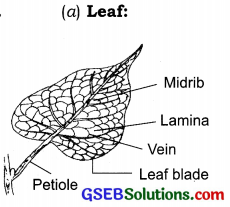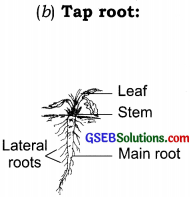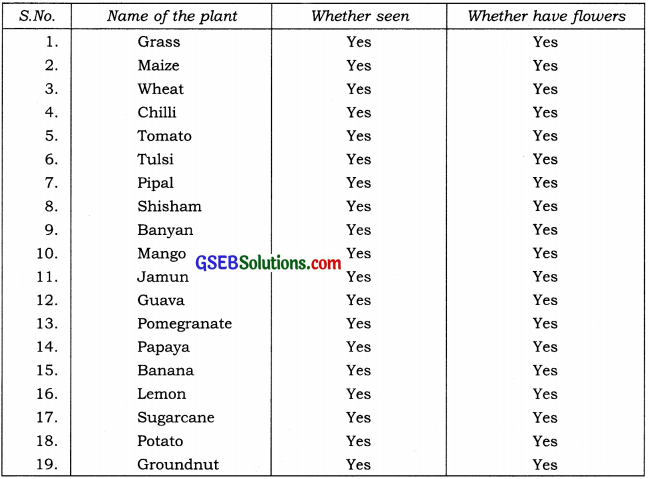Gujarat Board GSEB Textbook Solutions Class 6 Science Chapter 7 Getting to Know Plants Textbook Questions and Answers, Notes Pdf.
Gujarat Board Textbook Solutions Class 6 Science Chapter 7 Getting to Know Plants
Gujarat Board Class 6 Science Getting to Know Plants Textbook Questions and Answers
Question 1.
Correct the following statements and rewrite them in your notebook.
(a) Stem absorbs water and minerals from the soil.
(b) Leaves hold the plant upright.
(c) Roots conduct water to the leaves.
(d) The number of petals and stamens in a flower is always equal.
(e) If the sepals of a flower are joined together, its petals are also joined together.
(f) If the petals of a flower are joined together, then the pistil is joined to the petal.
Answer:
(a) Roots absorb water and minerals from the soil.
(b) Roots hold the plant upright.
(c) Stem conducts water to the leaves.
(d) The number of petals and stamens in a flower usually have no relation.
(e) If the sepals of a flower are joined together, its petals are not necessarily joined together.
(f) If the petals of a flower are joined together, then the pistil is not necessarily joined to the petal.
![]()
Question 2.
Draw (a) a leaf, (b) a tap root and (c) a flower, you have studied for Table 7.3 of the textbook.
Answer:



Question 3.
Can you find a plant in your house or in your neighborhood that has a long but a weak stem? Write its name. In which category would you place it?
Answer:
Yes, we find a money plant in our house. It is a climber.
Question 4.
What is the function of a stem in a plant?
Answer:
A stem performs the following functions:
- The stem and its branches hold leaves to get maximum sunlight.
- It transports water from roots to different parts of the plant.
- It transports food from leaves to different parts of the plant.
- It bears leaves, flowers, and fruits.
![]()
Question 5.
Which of the following leaves have reticulate venation?
Wheat, tulsi, maize, grass, coriander (dhania), china rose.
Answer:
Tulsi, china rose.
Question 6.
If a plant has fibrous roots, what type of venation are its leaves likely to have?
Answer:
Parallel venation.
Question 7.
If a plant has leaves with reticulate venation, what kind of roots will it have?
Answer:
Taproot.
Question 8.
Is it possible for you to find out whether a plant has taproot or fibrous roots by looking at the impression on its leaf on a sheet of paper?
Answer:
Yes, by taking the impression of the leaf. Put the leaf under a white sheet and gently rub the pencil on it with tip sideways. We will get an impression of the leaf with lines on it. If the leaf has parallel venation then the plant has the fibrous root and if the leaf has reticulate venation then the plant has a taproot.
![]()
Question 9.
What are the parts of a flower?
Answer:
The names of various parts of a flower from outside to inside are:
- Sepals
- Petals
- Stamens
- Pistil
Question 10.
From the following plants, which of them have flowers? Grass, maize, wheat, chili, tomato, tulsi, peepal, shisham, banyan, mango, Jamun, guava, pomegranate, papaya, banana, lemon, sugarcane, potato, groundnut.
Answer:

Question 11.
Name the part of the plant which produces food. Name the process.
Answer:
Leaves produce food for the plant. This process is called photosynthesis.
Question 12.
In which part of a flower you are likely to find the ovary?
Answer:
We find an ovary in the pistil. It is the lowermost part of the pistil.
![]()
Question 13.
Name two plants in which one has joined sepals and the other has separate sepals.
Answer:
Flowers with joined sepals:
- Datura
- Bottle gourd
Flowers with separate sepals:
- Rose
- Mustard